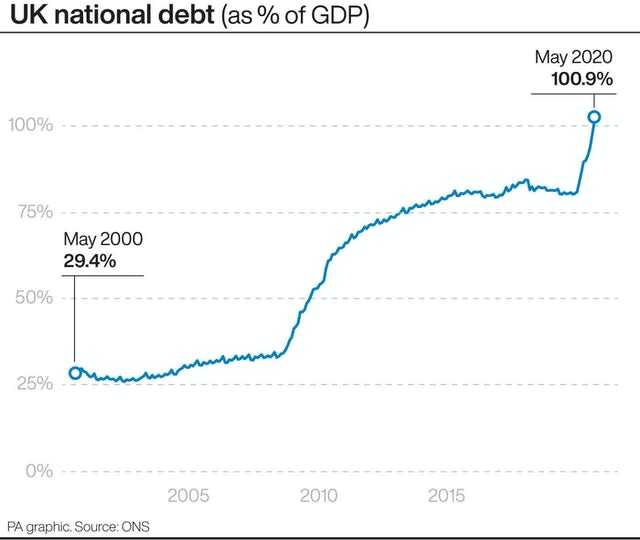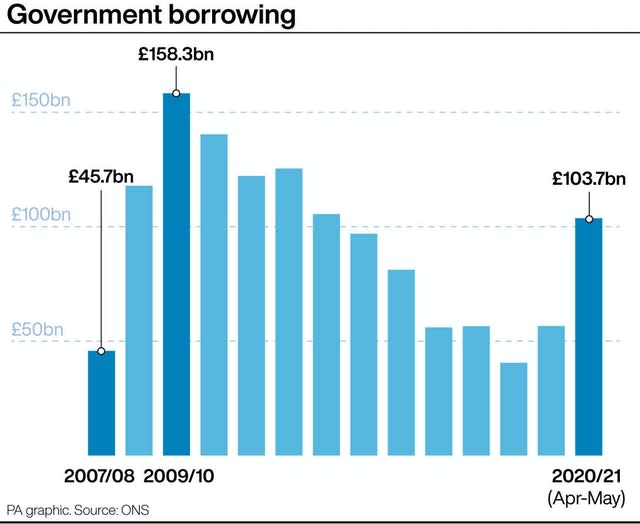Government borrowing hits £55.2bn in May to cope with Covid-19 economic fallout
Government borrowing surged to a new record high in May, hitting £55.2 billion and beating the newly revised £48.5 billion for April, following heavy spending in the face of coronavirus, according to new figures.
The Office for National Statistics (ONS) added that public sector borrowing – excluding banks owned by the state – was nearly nine times higher than the levels in May 2019.
It means the UK’s debt mountain has also now grown to more than the entire country’s output – gross domestic product – for the first time since 1963, officials added, to £1.95 trillion or 100.9% of GDP.

Prime Minister Boris Johnson predicted the fiscal results meant a “painful” recovery ahead.
April was previously thought to be the all-time highest borrowing month since records began in 1993, coming in at £62.1 billion, but officials on Friday revised this down by £13.6 billion due to larger-than-expected tax and national insurance contributions and lower costs associated with the Coronavirus Job Retention Scheme.
The furlough scheme is expected to cost the Treasury £60 billion by the time it closes in October, according to the Office for Budget Responsibility (OBR).
Borrowing in the current financial year-to-date, which is April and May, is estimated to have been £103.7 billion – up £87 billion on the same period a year ago and the highest two-month period on record.

The OBR has previously predicted last month that borrowing for the entire year is expected to hit £298.4 billion.
All the extra borrowing means debt at the end of May was £1.95 trillion, up £173.2 billion, or 20.5 percentage points, compared with the same month a year ago.
The amount of cash needed by the Government in May was also a record high at £62.7 billion, with £126.2 billion required in just April and May combined, the ONS added.
The last time national debt (as % of GDP) was as high as it is now, Harold Macmillan was PM and The Shadows were at number one. pic.twitter.com/n9IBoVYHWP
— Ian Jones (@ian_a_jones) June 19, 2020
Interest payments on the debts were £3.3 billion in May, up £0.2 billion from May 2019 as the amounts are linked to inflation.
The increase in borrowing came because central Government receipts fell 28.4% compared to May a year ago, at £40.7 billion, including £28.9 billion in taxes.
Value Added Tax (VAT), Pay As You Earn (PAYE) Income Tax and Corporation Tax receipts fell by 46%, 29.4% and 14% respectively, the ONS said, although officials were keen to stress the numbers could change when actual cash data is received.

Mr Johnson, asked about the debt levels during a visit to a school in Hemel Hempstead, Hertfordshire, said: “There has been a massive lack of economic activity for a very long time – of course that is going to be a painful and expensive to make up.
“But we are a very creative and dynamic society, we will come back.”
Chancellor Rishi Sunak said: “Today’s figures confirm that coronavirus is having a severe impact on our public finances.
“The best way to restore our public finances to a more sustainable footing is to safely reopen our economy so people can return to work.
“We’ve set out our plan to do this in a gradual and safe fashion, including reopening high streets across the country this week, as we kickstart our economic recovery.”

 Yahoo Finance
Yahoo Finance 